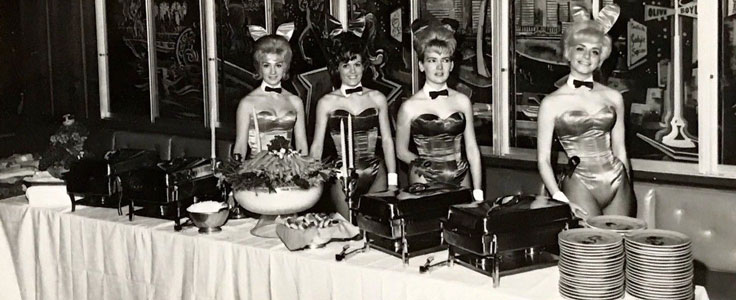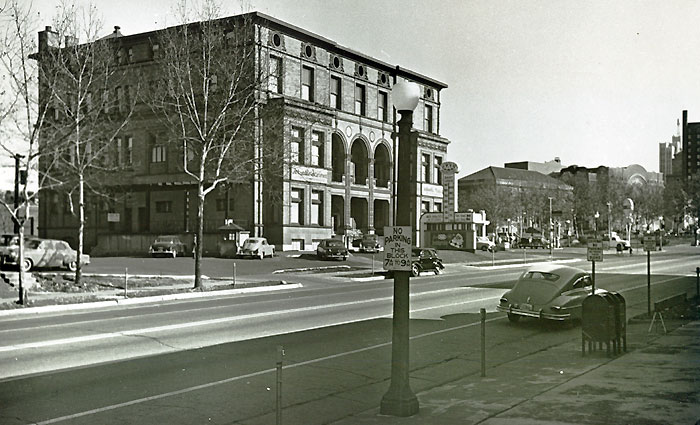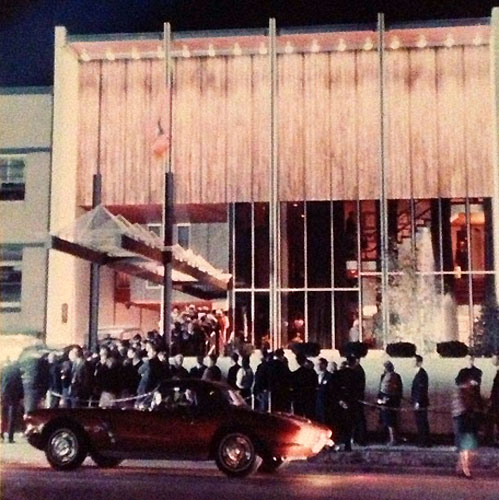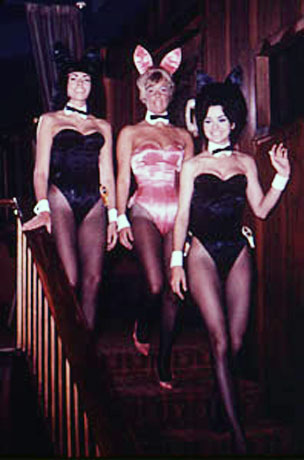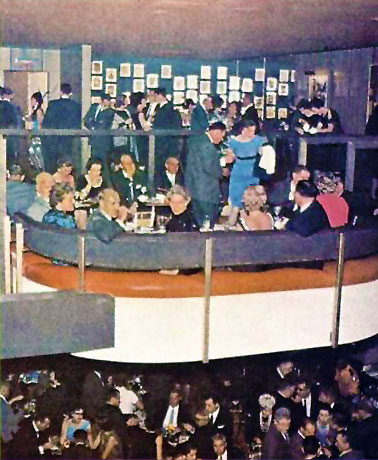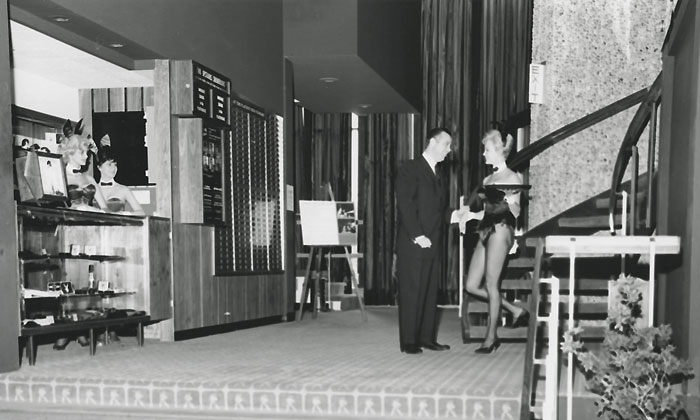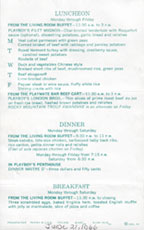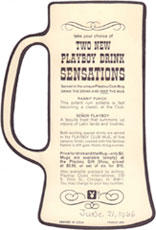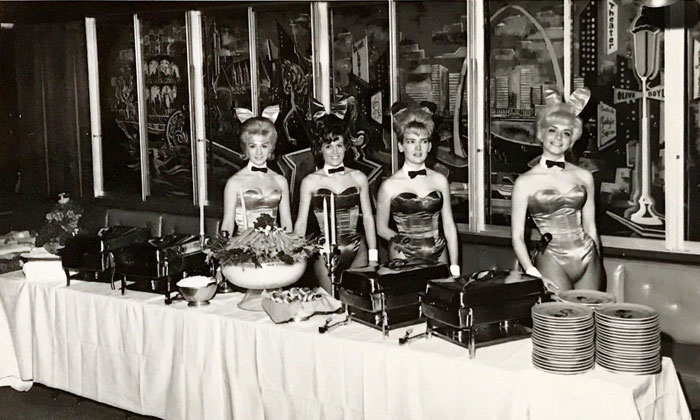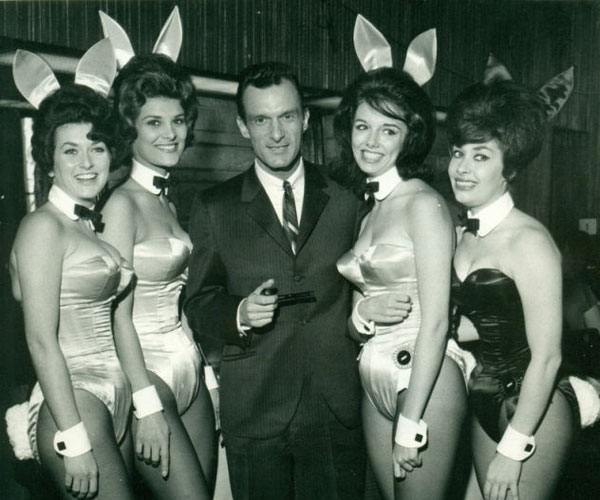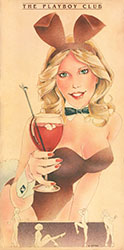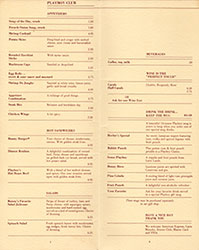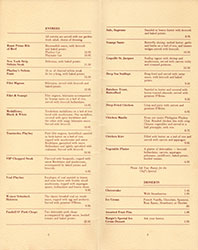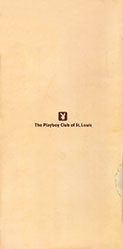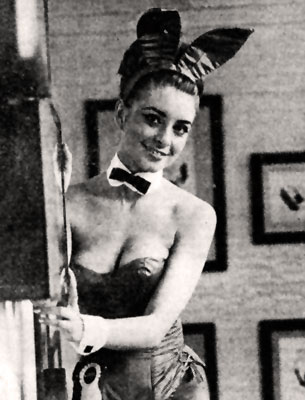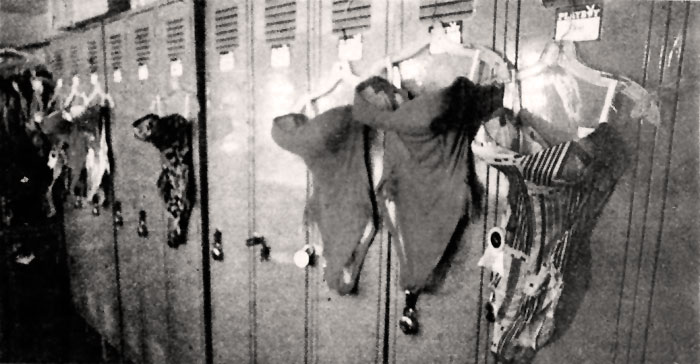|
Playboy Club
Hugh Hefner opened the first Playboy Club in
Chicago in 1960, and clubs were opened the following year in New
Orleans and Miami. Surprisingly, the fourth Playboy Club was built
in 1962 on the 3900 block of Lindell, across the street from the AAA
Motor Club, in the normally conservative city of St. Louis.
The grand old home of Ms. Ellen Huctson was cleared from the site to make way for the multilevel building. The St. Louis club was the only Playboy Club built from the ground up.
A series of pagoda shaped canopies extending
from Lindell to the club entrance, which was recessed 40 feet from
the street. The 18,000 square feet '50s modern structure had a glass
front exposing two of its three floors and a sunken patio garden in
its forecourt. Automobiles drove up to the club entrance and then
through a drive under the building to parking areas in the rear.
The announcement that a Playboy Club was to open in St Louis triggered a massive "bunny hunt."
Over 800 young women showed up at the Coronado Hotel on Lindell to apply. Forty-one bunnies were hired and sent off to "bunny school," a training program run by Hugh Hefner's brother, Keith. The St Louis Playboy Club would produce six Playmates of the Month and one Playmate of the Year. Its most famous playmate was Patti McGuire, who married local tennis star, Jimmy Connors.
The St Louis Playboy Club opened its doors
on October 16, 1962. The facility featured the Playmate Bar, Cartoon
Corner, the Piano Bar, the Library, the Playpen, which was used for
private parties, and the invitation only Penthouse. A barber shop, beauty
shop and club offices occupied space on the lower level.
The St. Louis Playboy Club was operated
under franchise by Cottontail, Inc., a
corporation formed by local investors, including William Horvath,
Mel Friedman, Herschel Price, Herb Koberman, James Gosserau, Gil
Newsome, Joseph Moore and Kingsley Wright. It catered exclusively to Playboy
key holders
and their guests, offering dining and luncheon facilities, as well
as evening entertainment. Membership was $25, with an additional $20
annual fee. The key with the bunny-head logo allowed entry into any
club nationwide. Within two years, the St. Louis Playboy Club had issued 17,600 membership keys. On weekends, waiting lines stretched west on Lindell for more than a block. Bobby Darin, whose hit "Mack The Knife" had just topped the charts, was refused his own table because the rooms were filled to capacity.
Among the unknown comics who broke in their
acts at the St. Louis club were George Carlin, Pat Morita, Flip
Wilson and Richard Pryor Ė all paid $300 a week. Harry Blackstone Jr.
was a fill-in act; Gabe Kaplan was a stand-up comic; and there was singing novice Lana Cantrell, Professor Irwin Corey
and Tiny Tim.
The Playboy Club closed its doors at 3914 Lindell Boulevard on September 25, 1975. Signs in front of the building and on the marquee advised customers that the club would reopen at a new site. * * * * *
Margie Stafford grew up in Belleville, Illinois. At
age 15,
she quit high school and eloped. She had a child, was divorced after two
years of marriage and traveled around the country with her son,
working as a waitress. Herschel Price, whose principal businesses had been the coffee company started by his father and real estate, was one of the investors in the St. Louis club when it opened in 1962. Stafford recalled, "When I met Herschel, I was 18 and he was one of the club owners. I called him 'Mr. Price.' In those days, he was a smooth bachelor around town. When he asked me to marry him, I said, 'Youíve got to be kidding!' He still says Iíve never said yes."
When the St. Louis Playboy Club closed its
doors in September of 1975, Herschel Price bought the rights to the
franchise from his partners and moved operations to South County.
Herschel and Margie Price reopened the club at the Ramada Inn on
South Lindbergh on New Year's Eve, 1975.
The new 800-seat Ramada Inn Playboy Club
represented what Herschel Price called the "second concept" for the
clubs. "Instead of a freestanding building, we thought, why not put
them in a hotel, where youíll also have all the hotel guests? Weíll
simply rent the nightclub facilities." It was still a key club, not
open to the public, with a key still costing $25, plus a $15 annual
fee.
Price explained, "In the beginning a real
playboy wouldnít have gone near a Playboy Club; we only had people
who wanted to be playboys. We went after the new franchise because
we saw this was changing and our new audience would be dating
couples, young married couples Ė the traditional nightclub
audience."
In September of 1976, five former bunnies sued the St. Louis Playboy Club. They had all worked at the club on Lindell and claimed they had been assured of jobs at the new location, but were not rehired "because of failure to maintain the bunny image," which Playboy defined as "the physical appearance of a bunny and the impression she conveyed to customers and others." The ex-bunnies asserted the definition was "arbitrary, capricious and allowed the employer to discharge without reason." Betty Bennett was the "bunny mother" at the Lindell club Ė hirer, trainer, adviser and judge. She wasnít happy with some of Playboy's bunny practices.
Margie Price was in charge of the bunnies at the Ramada Inn club.
Herschel and Margie Price chose not to renew their lease at the Ramada Inn and ceased operating the St. Louis Playboy Club as of the close of business on August 11, 1985. On June 30, 1986, Hugh Hefner closed the Playboy Clubs in Los Angeles, New York and Chicago. Hefner said closing the clubs "at last freed us from the attempt to make something old-fashioned seem like a contemporary symbol when it wasnít." The last of the original Playboy Clubs in America closed on July 29, 1988 when the distinctive, stylized rabbit came down from the awning entrance to the Hilton in Lansing, Michigan.
Copyright © 2020
LostTables.com |

